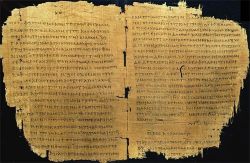Count Yourselves Dead to Sin, But Alive to God -- Romans 6:1-14
 Tuesday, December 11, 2007 at 11:22AM
Tuesday, December 11, 2007 at 11:22AM  The Thirteenth in a Series of Sermons on Paul's Epistle to the Romans
The Thirteenth in a Series of Sermons on Paul's Epistle to the Romans
Paul has made the point as clearly as he can: God justifies the wicked through faith in Jesus Christ. The ground (basis) of our justification is not our own works, but the merits of Jesus Christ–including his death for our sins, his one act of obedience through which the many made are made (declared) as righteous–received through faith alone. Therefore, we are not in any sense justified because of God’s work in us. Rather, we are justified because of God’s work for us. But in Romans 6:1-8:39, Paul will now make the point that all those justified will also be sanctified. Indeed, the apostle cannot conceive of someone who is freely and instantaneously justified by the merits of Christ who is not also undergoing the process of sanctification.
As we have seen in previous sermons, the literary hinge between Paul’s discussion of justification and sanctification is Romans chapter 5, especially verses 12-21. In the last ten verses of Romans 5 Paul sets out the panorama of redemptive history in very broad terms while also identifying the two main figures in the administration of the covenants, Adam and Jesus. Setting these two figures in contrast to one another, Adam is both the biological and the federal head of the human race. Under the terms of the covenant of works– “do this and you shall live”–Adam is the federal representative of the entire human race. Because of Adam’s one act of disobedience, Paul says, the entire human race is rendered guilty and comes under the curse of sin, which is death. In Adam we all sin. In Adam, we all die.
But Jesus Christ, the second Adam, is the head of the covenant of grace. Through his act of obedience (which stands in marked contrast to Adam’s act of disobedience), all those whom Jesus represents are regarded as righteous. Through the disobedience of the one man (Adam) the many were made sinners, so also through the obedience of Jesus Christ, the many were made righteous. As in Adam we were made sinners and subject to death, so in Christ we are reckoned as righteous, now set free from the tyranny of sin and death, so that in Christ we might live. As Paul puts it, where sin abounds, grace super-abounds.
The analogy between Adam and Christ, federal or representative heads of the covenant of works and grace respectively, becomes the basis for understanding much of Paul’s discussion of sanctification. Throughout Romans 6-8, all those in Adam, are said to be under the dominion of sin, the law and death. But all those in Christ are said to be set from the dominion of sin and the law, and now live with Christ. The analogy Paul sets out in Romans 5 between what Adam’s fall has brought about and what Christ’s obedience undoes, becomes the key to understanding what follows when Paul discusses sanctification. Doug Moo puts this in eschatological terms, speaking of a transfer of realms–from Adam to Christ. This eschatological focus also fits within the structure of so-called federal theology. Under the realm (dominion) of Adam we are condemned, because Adam is our representative under the covenant of works. We are justified when we are moved (transferred) by God’s grace from the realm (dominion) of Adam to the realm (dominion) of Christ under the covenant of grace.
To read the rest of this sermon, click here


Reader Comments